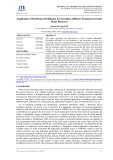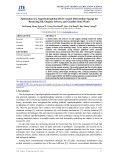
ISSN: 2615-9740
JOURNAL OF TECHNICAL EDUCATION SCIENCE
Ho Chi Minh City University of Technology and Education
Website: https://jte.edu.vn
Email: jte@hcmute.edu.vn
JTE, Volume 19, Issue 03, 2024
99
Degradation of Tetracycline by Composite Catalyst Derived from Food Waste
and Goethite
Huynh Quang Sang , Huynh Nguyen Cao Thong , Nguyen Thao Ha , Vo Thi Yen Linh , Nguyen
Duy Dat , Tran Thi Kim Anh*
Ho Chi Minh City University of Technology and Education, Vietnam
*Corresponding author. Email: anhttk@hcmute.edu.vn
ARTICLE INFO
ABSTRACT
Received:
07/05/2024
Current studies on the removal of emerging contaminants (such as
pharmaceuticals, personal care products, and their metabolites) from
environmental matrices have received a lot of interest due to their adverse
impacts on human health and ecology. Among these emerging
contaminants, Tetracycline hydrochloride (TCH) - has become a common
antibiotic prominent found in hospital and municipal wastewater. The
present research develops soybean curd biochar loading goethite (SBCG)
and soybean curd activated carbon loading goethite (SACG), a magnetic
material made from soybean curd residue and Fe precursor (α-FeOOH), for
advanced oxidation processes (AOPs) of TCH in aqueous solutions.
Soybean curd biochar loading goethite and soybean curd activated carbon
loading goethite demonstrated decomposition performances of 82.8% and
95.3% for the oxidizing agent H2O2 at pH 2, and 87.2% and 94.8% for the
oxidizing agent K2S2O8 at pH 7, respectively. Furthermore, the oxidant
utilized in the reaction was more H2O2 than K2S2O8. In which the initial
concentration was 70 mM H2O2 and 20 mM K2S2O8, the residual
concentration after the reaction was 19 - 22 mM H2O2 and 6.5 – 9.35 mM
K2S2O8 for SACG and SBCG. The consumption of H2O2 and K2S2O8 per
unit treatment agent for SACG material with an initial TCH concentration
of 300 mg/L was 75.5 and 20mmol oxidant/mmol TCH, respectively. This
demonstrates that combining K2S2O8 with SACG produces the most
beneficial outcomes, such as saving time, chemicals, and the amount of
post-treated water with a neutral pH value.
Revised:
04/06/2024
Accepted:
05/06/2024
Published:
28/06/2024
KEYWORDS
Advanced oxidation processes;
Adsorption;
Tetracycline removal;
Soybean curd;
Goethite.
Doi: https://doi.org/10.54644/jte.2024.1592
Copyright © JTE. This is an open access article distributed under the terms and conditions of the Creative Commons Attribution-NonCommercial 4.0
International License which permits unrestricted use, distribution, and reproduction in any medium for non-commercial purpose, provided the original work is
properly cited.
1. Introduction
Pharmaceutical residues have been recognized as emerging contaminants (ECs) in water bodies due
to the widespread use of medications for human and veterinary health worldwide, causing significant
dangers to aquatic habitats [1]. According to the WHO's statistical data, pharmaceutical industry has
been grown both domestically and internationally, and Vietnam, which was one of 17 nations that had
a thriving pharmaceutical industry [2]. Antibiotics are the most frequently and widely used medicines.
Antibiotics are incredibly essential and widely utilized in the treatment of human illnesses, animal
husbandry, and agriculture [3]. Tetracycline hydrochloride (TCH), an antibiotic used to treat certain
illnesses in humans and animals, is mostly released into wastewater as original chemical compounds
[4]. These results indicated that TCH residue might be commonly present in wastewater.
As a result, developing efficient and cost-effective solutions to remove TCH from the aquatic
environment is crucial. Several approaches have been used to remove TCH from water, including
photodegradation [5], biodegradation [6], catalytic oxidation [7], [8], adsorption [9], [10], and advanced
oxidation processes (AOPs) [11], [12]. Fenton treatment, a major technology utilized in AOPs, is the
preferred approach for removing TCH. Sulfate radical (•SO4-) based AOPs are gaining popularity for
their effective removal of organic contaminants. Compared to radical (•OH), (•SO4-) radical has a
longer lifespan, greater ability to selectively oxidize substances, and a broader range of pH adjustment

ISSN: 2615-9740
JOURNAL OF TECHNICAL EDUCATION SCIENCE
Ho Chi Minh City University of Technology and Education
Website: https://jte.edu.vn
Email: jte@hcmute.edu.vn
JTE, Volume 19, Issue 03, 2024
100
and was mainly produced by Peroxymonosulfate (PMS) and peroxydisulfate (PDS) [13]. PMS with
asymmetrical molecular structure makes it faster to activate and produce •SO4- than PDS [14].
Goethite (α-FeOOH) is non-toxic, and inexpensive material with a large surface area and many active
sites [15]. Goethite is commonly utilized as a catalyst for the removal of organic substances, such as
bisphenol A, which was substantially decomposed in the goethite-persulfate composition. However,
goethite's catalytic capacity to activate PMS was reduced since it was not stable and Fe(III) was
transformed to Fe(II) less effectively [16]. Therefore, to overcome these drawbacks, iron-based biochar
being created from sludge and agricultural waste, can be served as catalysts in heterogeneous Fenton
[16]. Biochar with high surface area can be used as an adsorbent for organic compounds and the recycle
of Fe(III)/Fe(II) may be considerably facilitated to improve the catalytic activity of iron-based catalysts.
For instance, the carbonyl group might be integrated with Fe(III), hence increasing •OH yields and
facilitating Fe(III)/Fe(II) transformation in the goethite/biochar/ H2O2 complex [13].
This study utilizes a high-temperature physical treatment (500 ℃) for converting raw soybean curds
residue to biochar (BC). After that, biochar was activated chemically with KOH to produce extremely
activated carbon (AC). Operational conditions for generating activated carbon were optimized by
changing the ratio of KOH/BC and pyrolysis temperature [17]. The catalytic materials will be
synthesized by a combination of BC and Goethite; AC and Goethite. Furthermore, with this background,
the current study focused on the efficiency of AOPs that use iron to remove TCH. AOPs formed
(•SO4-) based on the reaction of S2O82- and iron ion is significantly paid more attention than the Fenton
process (iron ion combined with H2O2 formed •OH). It investigated the efficiency of Fe/H2O2 and
Fe/K2S2O8 oxidation processes for TCH degradation under different operating settings (pH, contact
time, and initial H2O2 concentration). At the same time, high-level oxidation with a peroxy disulfate
radical catalyst (K2S2O8) is used to remove TCH during the oxidation process. This study will also aim
to compare the catalytic capacity of iron ions combined with H2O2 and K2S2O8 for AOPs on SBCG and
SACG materials produced by soybean curd residue and goethite to break down TCH.
2. Materials and Methods
2.1. Chemicals
All reagents and chemicals in this study (KOH, HCl, FeCl3.6H2O, ethanol 96o and Tetracycline
hydrochloride (TCH)) were of analytical grade and were prepared with deionized water.
2.2. Preparation of catalyst materials
Figure 1. Materials synthesizing processes
The synthesizing procedures used in this study with the optimized parameters was done in the
previous study [18]. Soybean curd residues from the tofu production process were gathered from
marketplaces in Ho Chi Minh City, Vietnam. Firstly, the soybean curd was dried at the temperature of
105 ℃ for 24 hours and sieved to reach a size less than 0.25 mm for storage; it was afterward known as

ISSN: 2615-9740
JOURNAL OF TECHNICAL EDUCATION SCIENCE
Ho Chi Minh City University of Technology and Education
Website: https://jte.edu.vn
Email: jte@hcmute.edu.vn
JTE, Volume 19, Issue 03, 2024
101
SC. To create biochar (BC), the sample was then pyrolyzed at 500℃ for 2 hours. The BC material was
stored in an airtight container for further activation procedures.
Next, activated carbon (AC) was prepared by mixing BC with KOH (ratio 1:4) for 2 hours using a
stirrer in a non-humor steel beaker with the same 25 mL of deionized water and then dried at 150℃ for
4 hours. After that, the solid mixture was crushed and pyrolyzed in an airtight oven at 800 °C for 2
hours. The AC mixture obtained after the pyrolysis process was crushed and stirred with distilled water
using a magnetic stirrer at 80 ℃. The excess OH- ions were eliminated by gradually adding a 1M HCl
solution to it. The reaction between HCl and a mixture of K2CO3 (formed by the reaction between BC
and KOH during pyrolysis) and residual KOH produced CO2, which stopped when the solution no longer
bubbled (the reaction was complete). After treatment, the solid mixture was washed with deionized
water to decrease the pH to 7 and eliminate any residue Cl- ions. Finally, SAC was dried at 105 ℃ for
24 hours before crushing and sieving to a size smaller than 0.075 mm.
Besides that, Goethite, which is also known as α-FeOOH, was produced through the synthesis of
FeCl3. Initially, a solution of FeCl3.6H2O 1M and a solution of KOH 5M were thoroughly combined
using a magnetic stirrer for a duration of 10 minutes. Subsequently, the resulting mixture was subjected
to a drying process at a temperature of 70°C for a period of 24 hours, allowing the ferrihydrite to undergo
aging and transform into goethite. As a result, the product underwent many washes using ethanol
(C2H5OH 45%) and deionized water until a pH of 7 was reached. The ultimate outcome was subjected
to a drying process at a temperature of 105 °C for a duration of 24 hours, followed by sieving process
to achieve a particle size of approximately 0.0105 μm [17].
To create the potential in the oxidation ability of the material, the BC sample was paired with α-
FeOOH to create new materials using a heterogenous oxidation process. The synthesizing process for
this material followed the preparing steps to generate goethite but with a minor adjustment [17]. Initially,
BC was added into the Goethite mixture with a weight ratio of 2:1. Then, the mixture was calcinated in
an air-tight furnace at 500 ℃ for 2 h. After pyrolyzing, the soybean residue biochar loading goethite
was referred to as SBCG. Similarly, Soybean crud-activated carbon loading goethite (SACG) was
synthesized using the same BC method as AC materials.
2.3. Analytical methods
The heterogeneous oxidation process of TCH onto the catalyst material was investigated by changing
the operational parameters (pH, contact time, and initial H2O2 or K2S2O8 concentration). The solid/liquid
(m/V) ratio was kept at 0.5 g/L for all experiments in this research by adding 0.02 g of material to 40
mL of 300 mg/L TCH solution. pH of solutions was adjusted by NaOH 1M and HCl 1M before and
during AOP. After that, the solution was mixed at 250 rpm in a shaker for a preset contact time at a
determined temperature. After finishing mixing, the mixture was filtered through a 0.45-μm
microfiltration. Besides that, the control sample was also done with the same procedure. The solids
collected from the filter paper were dried at 105◦C for 24h to examine the characteristics. The TCH
concentration before and after experiments was measured at 357 nm absorbance by UV–vis
spectrophotometer (U-2910, Hitachi Corp., Japan).
The residuals of H2O2 or K2S2O8 concentration were determined by the titration method. To titrate the
remaining H2O2, a 10 mL sample of 0.1N KMnO4 solution was poured into an Erlen flask, followed by
50 mL DI and 0.125 mL 1N H2SO4 [18]. The K2S2O8 residue was titrated with 0.025N Na2S2O3 in a 10
mL sample volume placed in an Erlene flask, followed by 0.025 g NaHCO3 and 8 g Iodine [19].
The surface morphology of materials and main surface elements was presented in the scanning
electron microscope (SEM) images and the energy dispersive X-ray spectroscopy (EDS) data (JSM-
6510 LV), respectively.
3. Results and Discussion
3.1. Effects of the solution pH
Figure 2 shows two TCH treatment processes including adsorption and oxidation. The equilibrium
period for the SBCG catalytic material was determined to be 90 minutes after the adsorption process
took place (Figure 2a). While the SACG catalyst material reaches equilibrium after 120 minutes of

ISSN: 2615-9740
JOURNAL OF TECHNICAL EDUCATION SCIENCE
Ho Chi Minh City University of Technology and Education
Website: https://jte.edu.vn
Email: jte@hcmute.edu.vn
JTE, Volume 19, Issue 03, 2024
102
adsorption (Figure 2b). These results demonstrate that the activation process of pyrolyzing biochar to
create activated carbon with KOH improved adsorption capacity. Furthermore, the results also indicated
that the solution pH from 3 to 9 did not affect significantly on the adsorption process in the range of 3 –
9. However, it was one of the most important factors in advanced oxidation processes.
Figure 2. Effect of pH (a) adsorption of SBCG, (b) adsorption of SACG, (c) H2O2 oxidation and (e) K2S2O8
oxidation for SBCG catalyst; (d) H2O2 oxidation and (e) K2S2O8 oxidation for SACG catalyst
Figure 2.c, d shows that pH affected on TCH elimination efficiency in the Fe/H2O2 system with 70
mM H2O2 for both materials. Under acidic environment, the degradation of organic matters for Fe/H2O2
was enhanced with 86.3% and 95.3% of TCH removal at pH 3.0 after 600 min for SBCG and SACG,
respectively. This results from the high oxidation ability of •OH in an acidic condition. When pH
increase, the oxidation ability of •OH is reduced [20] due to the dominant form of HO2– . The which had

ISSN: 2615-9740
JOURNAL OF TECHNICAL EDUCATION SCIENCE
Ho Chi Minh City University of Technology and Education
Website: https://jte.edu.vn
Email: jte@hcmute.edu.vn
JTE, Volume 19, Issue 03, 2024
103
the molar extinction coefficient of H2O2 was higher than that of HO2- in the Fe/H2O2 system [21].
Moreover, more Fe(OH)2+ radicals occur at pH 2 – 4, [22]. Compared to Fe2+, Fe(OH)2+ are more active
and readily react with H2O2 to generate •OH radicals. At pH > 6, mostly Fe(OH)3 and mostly Fe(OH)2
from pH 5 to 7. While Fe3+ precipitates quickly to Fe(OH)3 at high pH values, the reaction's treatment
efficiency declines as pH rises because Fe(OH)3 interaction with H2O2 does not produce •OH radicals.
Iron is primarily found as ferrous iron at pH 2 – 3, which promotes the creation of •OH radicals with
high oxygen activity. Additionally, a study conducted by Buxton revealed that the oxidation potential
of hydroxyl radical •OH is 2.8 eV at pH 2 – 3 and 1.9 eV at pH 7 [23]. The ability of this radical to
oxidize organic compounds decreases as the oxidation potential decreases.
Figure 2.e.f presents that pH did not significantly affect TCH removal using Fe/ K2S2O8 with 20 mM
K2S2O8. TCH removal effectiveness at various pH ranges was approximately 88.1% and 95.2% for
SBCG and SACG, respectively. This is slightly different in removal efficiency when pH was from 3 to
9. As a result, pH 3 was regarded as having the best efficiency, whereas pH 7 also performed the same
as the former. Additionally, to avoid the chemical waste of pH adjustment, the recommended optimal
pH was 7. This behavior corresponds to the production of •OH when •SO4- combines with OH- ion, as
shown in Equation (1) [21]. Therefore, •OH radical can contribute to the breakdown of organic
molecules in the Fe/K2S2O8 system.
•SO4- + OH- => SO42- + •OH (1)
3.2. Effects of the initial H2O2 or K2S2O8 concentration
Figure 3. Effect of the initial (a) H2O2 oxidation and (c) K2S2O8 oxidation for SBCG catalyst; (b) H2O2 oxidation
and (d) K2S2O8 oxidation for SACG catalyst)





![Bài giảng Xử lý nước thải công nghiệp ThS. Nguyễn Minh Kỳ [chuẩn nhất]](https://cdn.tailieu.vn/images/document/thumbnail/2019/20190814/tandlanh/135x160/860840055.jpg)
![Bài giảng Môi trường đô thị [mới nhất]](https://cdn.tailieu.vn/images/document/thumbnail/2015/20150929/mailai20796/135x160/9511443480091.jpg)
![Công nghệ màng MBR: [Thông tin chi tiết/Ứng dụng/Ưu điểm]](https://cdn.tailieu.vn/images/document/thumbnail/2013/20130403/hoangnhi2/135x160/6891364999568.jpg)









![Bài giảng Chế biến khoáng sản vô cơ [Mới nhất]](https://cdn.tailieu.vn/images/document/thumbnail/2025/20251025/thanhvan173002/135x160/21521761538638.jpg)








